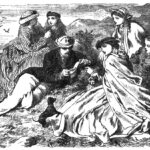Chandler, OK. My children were recently flabbergasted to discover that our little town has tourists. While walking to the library, one of them noticed a small group of people stopped on our main street taking pictures of an old Phillips 66 station. They seemed to be speaking a foreign language, maybe German or Dutch. When this discovery was reported at the dinner table, all three kids incredulously demanded to know why anyone would want to tour Chandler, Oklahoma.
My wife and I tried to explain that lots of tourists, foreign and domestic, enjoy driving through the heartland on historic Route 66, a stretch of which forms our traditional small-town main street. We explained that Chandler’s shop-lined main street and turn-of-the-century homes strike visitors as somehow quintessentially American. We pointed out the local pioneer history museum and the historic national guard armory. To some travelers, we explained, it is interesting to see cows.
What we were trying to convey to our children is that, when looked at from afar, we live in a “myth.” It is easy to miss that fact, since Route 66, the historic homes, the museum, and the cows all seem quite substantial and real. They are quite real, as are the lives lived here in small town America. Yet places like my hometown also represent something. America’s small towns signify collectively the way our major cities signify individually. There is a real New York, and there is the mythic “Big Apple.” There is a real Chicago, and there is the Chicago of Auggie March or Carl Sandburg’s “Hog Butcher for the World.” Chandler is a very real and particular place, with a particular history and particular human lives, but to many people it is also a part of Grover’s Corners, Mayberry, or Smallville. It is a little piece of Spoon River.
In Spoon River America: Edgar Lee Masters and the Myth of the American Small Town, Jason Stacy explores the changing and contested myth of the midwestern small town, particularly in relation to Masters’s famous Spoon River Anthology. Stacy traces the social and political contexts that shaped Masters’s famous collection of poems about the hidden side of small town life, and he explores how those poems shaped the way Americans think about our small towns. Rather than occupying one defined position in American popular mythology, the idea of the small town, Stacy argues, has been a site for contested ways of thinking about American life. In Spoon River and its echoes throughout literary and popular culture, innocence struggles with cynicism, tradition with modernity, and a persistent populism with a perpetual elite.
Spoon River Anthology is the only work of any contemporary or lasting relevance produced by Edgar Lee Masters in his long career. An immediate literary sensation that became a staple of high school curricula in the century following its publication in 1915, Spoon River Anthology is a fairly thick collection of monologues, often referred to as “epitaphs,” spoken by the deceased residents of a fictional town called Spoon River, Illinois, which Masters based on two small Illinois towns he lived in as a child and adolescent. Both the free verse in which the poems were composed and the monologue’s frequent discussion of repressed desires and suppressed personal authenticity helped to connect the book to the exciting early development of American literary modernism. Although much of Masters’ remaining oeuvre is written in formal verse with a slight whiff of the archaic—the formal habits of the “Fireside Poets” without any of their clarity or force—Spoon River Anthology takes up a direct and occasionally even muscular kind of free verse rooted in Whitman and similar to Sandburg and Williams, although one wishes Masters had Williams’s genius for line breaks, as the Spoon River poems often fall into a plodding free verse somewhat over-determined by syntax. Jason Stacy effectively shows how this combination of directness and accessibility combine with the dramatic—occasionally lurid—nature of the monologues to keep the poems perennially popular among high school students and among what is left of the general reading public.
Stacy doesn’t offer so much a direct line of argument about Spoon River Anthology as he does a general cultural excavation centered around the poem. The book takes up political and cultural history mixed throughout with biographical sketches of Masters, close readings of various Spoon River poems, and examination of the varied manifestations in the popular press of the small town mythos. The book is part critical interpretation and part reception history.
One of the most interesting threads throughout Stacy’s study is the populism that both shaped Masters’s work and was perpetuated in the poems’ long reception. Stacy shows how Masters stayed loyal throughout his life to a populism that was rooted in his father’s experiences during the Civil War. The elder Masters, while opposed to slavery, developed Southern sympathies during the course of the war, and the poet believed throughout his life that his father being branded a “copperhead” was the cause of his family’s financial struggles. Stacy situates this family history within the larger postwar divisions in Illinois that led to populist resentment of a financially powerful elite that had its roots in New England and Calvinism. The Masters men, and many others in their social and financial rank, came to believe that a wealthy elite was bleeding the common man dry while attempting to force a latter-day New England puritanism on the rest of the country. Both Edgar Lee Masters and his father, Hardin Masters, were present at the Democratic convention in Chicago in 1896 when William Jennings Bryan gave his famous “Cross of Gold” speech. According to Stacy, these divisions explain why “Masters divided Spoon River between the moralizing financial elite and the noble, but often tragic mass[.]” The two great villains of the Spoon River Anthology are the banker Thomas Rhodes and the prohibitionist A.D. Blood. Coming early in the twentieth century, Spoon River Anthology is shaped by the populism of the late nineteenth century, and in some ways it enshrined the populist sentiment to linger in literature and pop culture long after the heyday of the political movement, evident even in popular, anti-elite films such as The Best Years of our Lives, It’s a Wonderful Life, and, much later, Footloose.
That Masters’s populism was engaged in a struggle not just with the gold standard but also with the moral standards of the elite can be attributed to the influence of Freud. Or, at least, the Freudian view of neuroses as developing out of repression augmented Masters’s distaste for what he saw as elite moralizing. At times Spoon River Anthology seems to be nothing more than an anthology of tragically repressed desires. With a few heroic exceptions, the residents of Spoon River seem to have been doomed to stunted, unfulfilling lives. The voice of Serepta Mason seems to speak for them all when she says, “My life’s blossom might have bloomed on all sides / Save for a bitter wind which stunted my petals / On the side of me which you in the village could see.” The “village” seems to function as an all-seeing superego, always pushing against the id, usually in ways that maim the lives of Spoon River’s inhabitants. Stacy argues that literary men like Masters “reached middle age in a period of shifting discourse regarding human sexuality, primarily toward a Freudian conception of repression, which gave them the language and even the ethical imperative to outgrow the nineteenth-century moralisms of their hometowns.” According to Stacy, Freud was part of the “cultural landscape” of literary America when Masters was composing his Spoon River poems, which explains why so few of the residents of the Spoon River cemetery are at rest. They are still tormented by unfulfilled desires that respectable small town life pushed beneath the surface.
This concept of a struggle between natural desire and a repressive order plays a key role in the literary phenomenon that the eminent critic Carl Van Doren dubbed “Revolt from the Village.” Stacy devotes a key chapter to this “revolt,” and it helps us understand how Spoon River Anthology can be seen as representing a pivot in the place of the small town in America’s cultural imagination. The groundwork for this argument is laid early in the book where Stacy illustrates how, in the first half of the nineteenth century, an ideal vision of the rural New England village was contrasted in the public imagination with the wickedness of the urban environment. He offers plentiful journalistic and literary evidence for this idealization. As settlement moved westward, this sentimental lens was transferred from the New England village to the midwestern small town, with a shift of emphasis from the virtuous founding to the heroism of the pioneers. Van Doren saw Masters’ Spoon River Anthology as leading a revolt against this sentimental view of small town life, a revolt joined also by Sherwood Anderson’s Winesburg, Ohio and Sinclair Lewis’s Main Street, among other books. According to Stacy, “the village rebels in Van Doren’s terms created a new folk tale for Americans in the twentieth century about an individual who knew the community’s true nature and conspired with the audience to divulge its undisclosed secrets for the sake of self-fulfillment.” The major tactic in this “revolt” was to reveal the “buried life,”—the hidden lust, greed, and violence—beneath the respectable surface of the small town.
Spoon River certainly has its share of dark secrets. There’s Searcy Foote, who murdered his wealthy aunt when she wouldn’t give him money for college. There’s Deacon Taylor, upstanding church goer and prohibitionist, who died of cirrhosis of the liver from secret alcoholism. Several poems piece together the sordid story of Minerva Jones, the “village poetess” who, impregnated by Butch Weldy in what might have been a rape, died in the process of aborting the baby. The scandal and subsequent indictment ruined the career of kindly Doctor Myers, who attempted the abortion. Due to rumors that Dr. Myers was the father of Minerva’s baby, his wife “perished of a broken heart.” The doctor himself soon died of pneumonia, and Butch Weldy seemingly got his cosmic comeuppance when he was blinded and maimed in an explosion at the canning works. Minerva’s final words, “I thirsted so for love! / I hungered so for life!” seem to tie this exposé and the “revolt” described by Van Doren to the Freudian sense of buried desire that informed Masters’s storytelling.
Yet there is more to the Spoon River Anthology than a popularized and sensationalized Freudianism. There is in much of the work a tragic sense of life that gives dignity to the characters even in their sordid circumstances. This tragic view, which Stacy clearly identifies, is not the tragedy of a malicious fate, as in Oedipus, but rather the tragedy of a cold, indifferent cosmos, as in Thomas Kyd’s Spanish Tragedy or Shakespeare’s King Lear. It is the distinct tragedy of a secularized modernity. The same sorts of characters who reveal the sordid underside of small town life also reveal the tragic view at the heart of Masters’s vision. These characters are described by Stacy as “exiles,” even when they stay in their hometown, and seem often to be associated with the voice of the author. “Spoon River’s exiles offer blunt wisdom that invites the reader to mediate on a cold universe,” Stacy argues. These characters include Thomas Ross Jr., who sees the brutality of nature as evidence of an indifferent universe. In a similarly Darwinist vein, a character called only “Professor Newcomer” asserts that “The urge of nature that made a man / Evolve from his brain a spiritual life” is nothing more than “a joke of cosmic size.” This is a bleak assessment, but in the best of Masters’s poems it provides the kind of comprehensive vision necessary for great art.
Once could get the impression from scholarly books such as Spoon River America that small towns are all myth. Of course they are not. Small towns like my own Chandler are real places where real lives—with all the attending adventure, adversity, and mundanity—are lived. Yet it is helpful to think about how our very real small towns are generalized and abstracted into myth in the national imagination. While Spoon River America contains much that will be of interest perhaps only to the scholar of American literature, it also has much to offer a less specialized reader. The best works of literary criticism send us back to the books they focus on, and Stacy’s study certainly sent me back to Spoon River. While there, it also sharpened my perspective on the small town—both its reality and its myths—in which I live.






